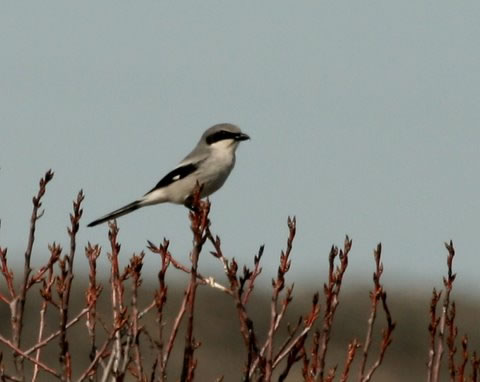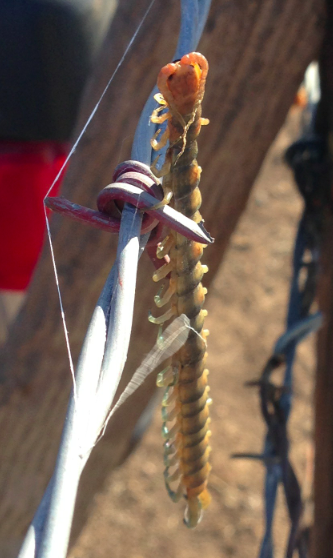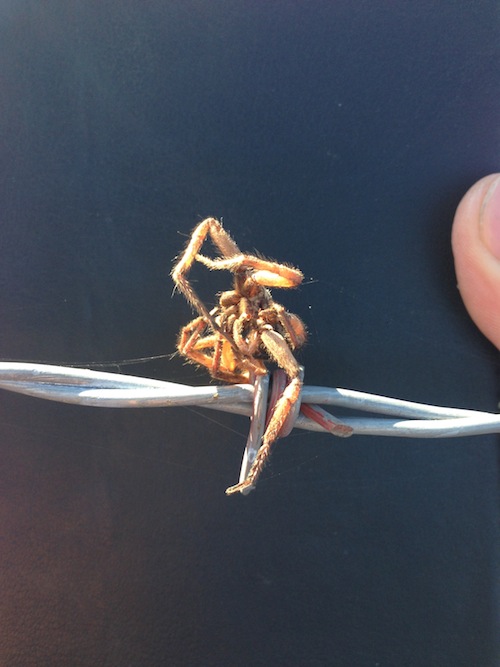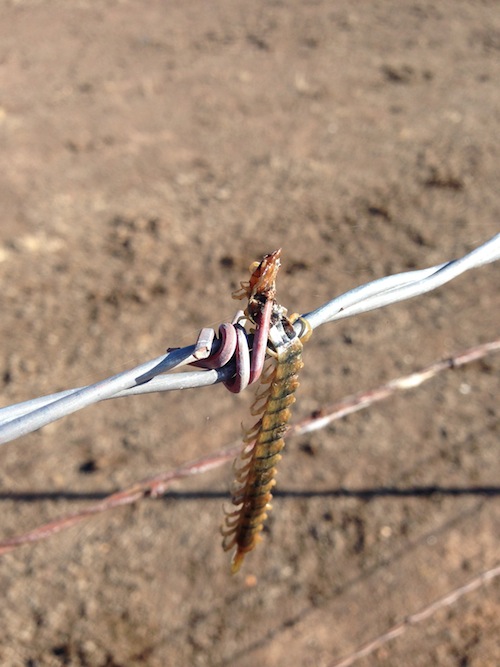Loggerhead Shrikes are unusual because they look like a songbird (and they are one!) yet they act like a raptor. Shrikes feed on large insects, spiders, lizards, mice, and even small songbirds. They hunt over open terrain that provides a broad view of the countryside. Shrikes often spot their prey from a low perch. After a short flight, followed by a pounce, they land on their prey and usually quickly carry it off. But before they can eat their catch, they must first kill it. To accomplish this the shrike needs help. Shrikes have a large, sharp bill, but they lack of the raptoral feet and talons like those of hawks and owls. With stong talons and leg muscles, raptors can easily squeeze, kill and then dismember their prey. Without such anatomical tools the shrike must rely on something else.....
 Which brings us to these closeup photos taken by reserve intern Daniel Toews last Monday. While collecting rain water from our three rain gauges as part of our air pollution study, Daniel spied a shrike at the Hercules Powder water tank near the center of the reserve. After the shrike flew off, Daniel's attention was drawn to the barbed wire fence where the bird was perched. Here he was surprised (and pleased?) to find two large, fresh centipedes and a large spider - all dead. They'd been impaled on the barbs and were hanging limp on the fence. Daniel had just observed a fascinating piece of local natural history - the killing grounds of a Loggerhead Shrike. Without the talons needed to completely subdue their prey, shrikes use the sharp barb of a barbed wire fence, or the long spine of a cactus, locust, rose bush or some other spine-bearing plant. Prey such as a scorpion or lizard can be dangerious. They can bite, sting or scratch. To be able to consume their prey safely without being harmed in the process, the shrike needs to first kill their prey. While the shrike is capable of severing the vertebral column of, say a mouse, ripping and eating that mouse or a lizard is not easy. A spine or a sharp barb does the trick. Using the spine to immobolize the prey allows the shrike
Which brings us to these closeup photos taken by reserve intern Daniel Toews last Monday. While collecting rain water from our three rain gauges as part of our air pollution study, Daniel spied a shrike at the Hercules Powder water tank near the center of the reserve. After the shrike flew off, Daniel's attention was drawn to the barbed wire fence where the bird was perched. Here he was surprised (and pleased?) to find two large, fresh centipedes and a large spider - all dead. They'd been impaled on the barbs and were hanging limp on the fence. Daniel had just observed a fascinating piece of local natural history - the killing grounds of a Loggerhead Shrike. Without the talons needed to completely subdue their prey, shrikes use the sharp barb of a barbed wire fence, or the long spine of a cactus, locust, rose bush or some other spine-bearing plant. Prey such as a scorpion or lizard can be dangerious. They can bite, sting or scratch. To be able to consume their prey safely without being harmed in the process, the shrike needs to first kill their prey. While the shrike is capable of severing the vertebral column of, say a mouse, ripping and eating that mouse or a lizard is not easy. A spine or a sharp barb does the trick. Using the spine to immobolize the prey allows the shrike  to rip apart and ingest. Hence, their nickname: the butcherbird. Impaling behavior is a unique solution and adaptation that enables this relatively small bird to fill the niche of a top-l
to rip apart and ingest. Hence, their nickname: the butcherbird. Impaling behavior is a unique solution and adaptation that enables this relatively small bird to fill the niche of a top-l evel predator, quite similar to that of much larger raptors such as the American Kestrel or Burrowing Owl.
evel predator, quite similar to that of much larger raptors such as the American Kestrel or Burrowing Owl.
Impaling behavior can serve another function. Male shrikes will try to attract a mate by impaling numerous prey in a conspicuous location. In the southern New Mexico desert, ornithologists discovered 23 horned lizards, bird bills, and feathers festooned on a Torrey Yucca. Very attractive! To a female shrike this would certainly indicate a mate that has excellent hunting and providing skills. A good father he would make.

Loggerhead Shrikes deserve our attention for another reason besides their skillfull meal preparation. According to the Cornell Laboratory of Ornithology, "Despite its wide distribution, the Loggerhead Shrike is one of the few North American passerines whose populations have declined continentwide in recent decades. Changes in human land-use practices, the spraying of biocides, and competition with species that are more tolerant of human-induced changes appear to be major factors contributing to this decline."
The next time you're out on the Reserve be sure to scan the barbed wire fences and look for a small gray, black and white bird perched on the top strand. And marvel at the shrike, an animal that has evolved a unique solution to satisfying their nutritional needs.


